Last Updated on June 25, 2015 by Steve Hogg
NOTE: This post was originally entitled MATERIAL CHALLENGES: Scary Movie – How to lessen your ability to coordinate your actions without being aware of it. The Scary Movie part of the title has been deleted for reasons that will become obvious below.
Here is where we delve into bike fitting esoterica. There’s a lot of info on the site that is nuts and bolts stuff. Information that can be applied to improve how you interact with your bike. However, there is another level to bike fitting; the really fine detail that can make a perceptible difference for some clients, and this post is about one aspect of that.
There’s a couple of things that needs outlining before reading what follows below so as to place what you’ll read in context. If what you read seems hard to believe, there are step by step instructions following that will allow anyone with a little anatomical knowledge to duplicate what I talk about.
Firstly, read this post as background, as it will help make sense of what follows. Pay particular attention to the concept of Challenge and it’s implications.
Next a bit of history. About 7 years ago I started working on a way to quantify the degree to which the Central Nervous System (CNS) paid attention to the proprioceptive output of the feet and to restore that ‘connection’ as a priority task for the central nervous system. As you have read in Bike Fitting Philosophy – Basic Premise, I consider this a big deal. This didn’t happen instantly. It was the product of a lot of incremental realisations and discoveries over several years, each of which I could test empirically and build on. There were quite a few traps along the way; all of which I fell into. Those traps and the experience of understanding them and how to avoid them, furthered my knowledge of what is and isn’t possible when playing with procedures that ‘sharpen’ the CNS awareness of the feet.
Basically on a bike, allowing the reception of the proprioceptive output of the feet to be taken on by the CNS as a priority task all comes down to foot correction. No big deal there. The big deal is that you only have perfect long term autonomic awareness of the feet on the bike, loud and clear, if you have the individually perfect balance and placement of arch support, rear foot correction, and forefoot correction in whatever combination is dictated by the outcome of my testing procedure.. This doesn’t mean that you can’t ride a bike without perfect proprioceptive feedback from the feet; you can, but at some level, great or small, your ability to coordinate the pedaling action will not be as good and the compensations that you automatically and asymmetrically adopt that allow you to work around this lack, increases the chance of developing overuse injuries over time. Some people pedal for a lifetime without perfect proprioceptive response from the feet and don’t ever notice the lack. Others never progress beyond a certain level of proficiency or tendency to injury because of the lack. Such is the variety of humanity.
The testing procedure I evolved also showed me that a large number of cyclists require rear foot correction in addition to arch support. There is a need for forefoot correction in many cases and a need for a mix of rear foot and forefoot correction in others, but a majority need rear foot correction either alone or in combination with forefoot correction. It also taught me how sensitive to input the CNS is. A single degree of correction too little, too much, or in the wrong place, muffles the cerebellum’s awareness of the feet markedly (while pressure is being exerted on the pedals) and triggers asymmetric patterns of compensation. You need to understand here that proprioceptive feedback from the feet (and everywhere else in the body) always reaches the cerebellum. What matters is whether it is paid attention to.
The issue being that humans generate something like 1.5 million times more proprioceptive output than the CNS can ever process in any given second. The guts of my testing protocol and restoration procedure is that it allows the proprioceptive output of the feet to stand out from all of the background ‘noise’ and be taken on and acted upon as a priority task for the CNS without conscious thought. This benefits performance and reduces chance of injury via enhanced neuromuscular coordination and reduced tendency to (asymmetrically) compensate.
In the post I asked you to read above, a Challenge is any factor that decreases stability or increases any tendency to asymmetry of the rider. Challenges fall in to 3 categories, Positional, Functional and Neurological. A subsection of Neurological Challenges is what I call Material Challenges. Any Challenge to the rider will evoke a pattern of compensation. All compensatory responses to a Challenge increase the functional asymmetry of the rider and by so doing, increase the likelihood of overuse injury, because the rider is functioning with increased asymmetry while being in a more or less fixed relationship with a positionally symmetrical bike.
A simple example is the Challenge of too high a seat height. If the seat is too high, it is exceedingly rare for the rider to sit symmetrically on the seat and overextend both legs equally. Almost invariably, the rider will hang to one side (usually the right / occasionally the left) and overextend one leg more than the other.
The key thing to remember about Challenges is that many result in a lateral pelvic shift, and it is this shift which increases the functional asymmetry of the rider. The legs hang down from the pelvis, the torso extends from the pelvis, so any change to pelvic alignment can have an effect on remote parts of the body. Material Challenges can arise from unlikely sources.
Several years ago I began to experience an inability apply my procedure of quantifying and maximising proprioceptive feedback from the feet to some fitting clients. In each case these clients were using Specialized in shoe wedges. At the time I was using Bike Fit in shoe wedges as a diagnostic tool and wasn’t having any problems with them. So I removed any Specialized in shoe wedges that fitting clients had and ‘Hey Presto’ my procedures worked again, which of course, tweaked my interest.
Then Specialized released leg length compensation shims to suit a variety of pedal systems and the same damned problem arose with any clients who came if with Specialized leg length shims already fitted.
Bear in mind, that the Specialized in shoe wedges and Bike Fit in shoe wedges have the same taper and approximate appearance. Specialized shims and shims that we’ve been producing for the last 7 years perform the same task; they raise the foot above the pedal. The difference in response had to be the material of the products themselves, not the shape. After a bit of research and some educated guesswork, I felt that I had an idea what the likely problem was. So I had a comparative analysis done of the material make up of the problematic items versus the non problematic items on a mass spectrometer. The information that I gained from that means that I am reasonably sure what the problem is with the material makeup of Specialized in shoe wedges and shims.
I contribute to the Fitness Forum on CyclingNews which is a Q&A forum where cyclists can seek answers for a variety of problems. At around the same time that I got the chemical analysis report back, a query came my way via the Fitness Forum. Based on what the querier told me of his issues and equipment, I told him to remove his Specialized wedges and he should resolve the issue, which apparently it did. These and similar Q & A posts were later deleted by CN because they felt they were leaving themselves open to legal issues arising from what I was saying. Particularly as I wasn’t prepared to explain the method I had used to determine the problem.
My reluctance to explain how I came to my view about the Specialized in shoe wedges and shims was because I was part way through the process of patent grant for my testing protocol re quantifying and maximising proprioceptive feedback from the feet. Publicly revealing how I had worked out what the problem was with the Specialized stuff would have invalidated my patent applications on ‘knowledge already in the public domain’ grounds.
Well things have moved on in several ways. Firstly, the patent applications are further along but still ongoing. (Stop Press: Patent approved in U.S.A, U.K., Australia and New Zealand)
Secondly, I found a number of other items commonly used by cyclists triggered the same clouding of proprioceptive feedback from the feet. It isn’t just Specialized shims and wedges. Other items with a negative effect are some brands and models of generic arch supports for shoes, most plastic charity style plastic wrist bands, Power Balance bracelets, one brand of bicycle inner tube and rim tape, many sunglasses; certainly a majority of black plastic framed sunglasses, including many big name brands / models, and the anti glare coatings on some prescription lenses and the coatings on some sunglass lenses.
Lastly, I’ve found that there is another consequence of the inhibitory effect of these products. All result in a lateral pelvic shift in standing posture.This means that I can tell you what happens without invalidating my patent pending testing procedure. One of the purposes of this site is to provide real world empirically tested bike fitting info that works as an antidote and counterbalance to the formulaic, marketing driven stuff, of which there is an overload out there. I’ve wanted to talk about this subject for some time, so here it is.
The original idea for this post was to have a Physician that I have shown this stuff to, demonstrate the pelvic shift on camera by drawing attention to the relative heights of the subjects iliac crests on film on a before and after basis. He was willing, we had subjects, a camera man and film, but we struck a hitch. The camera had to be far enough behind the subjects to show them from head to foot. This is necessary because I wanted to show that any of the items listed below can be a problem if placed within a metre and a half of a person. With subjects stripped to the waist, the movement of the pelvis when subject to Material Challenge was obvious to all in the flesh. On film, the low contrast of a large area of white skin filmed under bright lights from several metres back and reduced to the size of a computer screen, didn’t show what I wanted nearly as clearly as in the flesh as it did with the naked eye. I mentioned this post as “coming soon” a couple of weeks ago and don’t want to drag things out and so have decided to go ahead anyway, in the sense of listing a protocol that can be duplicated by readers. My Physician friend is trying to get hold of a portable ultrasound machine. If / when that happens, then there will be an addendum to this post with the ultrasound scans of pelvic shifts added.
Follow the instructions below and you will be able to duplicate what I’ve talked about above with any problematic object providing you have enough anatomic knowledge to accurately and repeatedly find the iliac crests. This is not hard to do, but you need to know what you are looking for, so it helps if you’ve had practice. I know a number of structural health professionals regularly read the site, so if any of them care to duplicate the protocol below, I’d be interested to hear what they have to say.
1. Find a subject that does not display a lateral pelvic tilt in standing posture. This isn’t as easy as it sounds but there are plenty of people like this out there. If this isn’t possible, use whomever you have. If they have a pelvic tilt, place a partly opened magazine under the foot of the low side until the iliac crests on both sides are level. Strictly speaking, this isn’t necessary, as the pelvis will shift anyway; but if you are not practised at this, it is easier to see the shift if the starting point for the pelvis is that it is levelled between iliac crests.
2. Have the subject strip to the waist and remove their shoes and socks. Now have them sit on a low, firm stool facing away from you and extend their arms as hard as they can towards the ceiling. Check from the rear that both iliac crests are level in seated posture while they do this. This is merely to check that your subject is not one of the fraction of 1% of riders who has a pelvis that is smaller on one side than the other.
3. Have the subject stand barefooted facing away from you. Before moving on to step 4 etc, make sure that any item you are testing is at least 2 metres away from the subject. Sensitivity to these objects varies from half a metre to up to 2 metres in some people I have tested.
4. Locate their posterior iliac crests and confirm that left and right sides are level. If they are not level, note down the approximate difference in heights between left and right sides .
5. Remove your hands from the subject and have them hold a problematic object in one hand. Removing your hands is necessary so that the subject does not have pressure from your hands to help them locate themselves in space. While I prefer this method, the majority will shift if exposed to a Material Challenge whether your hands are on their iliac crests or not, and the tester will be able to feel the shift in many cases.
6. Now recheck the position of both iliac crests. You will note that the subject’s iliac crest is now higher on one side than the other. Typically 5- 20mm higher, with 10 -12 mm being the most common response. It is more common for the left iliac crest to rise but a significant minority raise the right side. If your subject didn’t have level iliac crests, there will still be a shift if the item is a problem, with the shift being in either direction. That is, if not level as a starting point, the pelvis may become more level or less level if there is a problem with the item.
7. Remove the object from the subject’s hand and make sure that it is at least 2 metres away from them. Now recheck iliac crest height and you will find that the crests are level again. Or back to their original relationship, if not level to start with.
8. Place a problematic object on the floor near to, but not touching the subject. Say 100mm (4″) – 150mm (6″) in front of them. This can be done with or without a blindfold worn by the subject.
9. Recheck iliac crest heights and you will again find that there has been a shift with one side noticeably higher than the other. Keep repeating this test while moving the object further from the subject and you will find that the effect is present with the problematic object up to half a metre away with just about anybody, and up to 2 metres away in the occasional subject.
What are the problematic objects?
MOST PLASTIC CHARITY BRACELETS
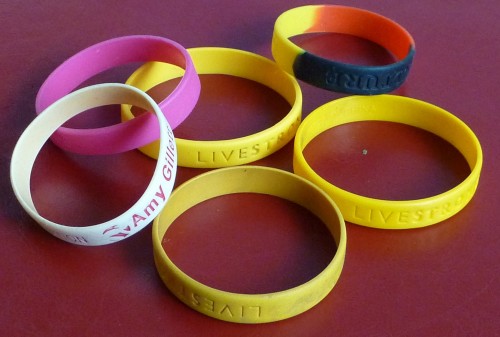
I tripped over this when fitting a rider some years ago. I used my testing protocol off the bike to determine what amount and placement of foot correction he needed and but could not get a response from his feet on the bike. After much hair pulling and frustration, I found a Livestrong bracelet wrapped around his spare tube in his tool bag. Once that was removed, end of problem. Subsequently, I started testing the effect of the plastic charity bracelets that clients came in with. This was around the time that charity bracelets first appeared. To date, the effect is the same with all of them.
SPECIALIZED IN SHOE WEDGES AND SPECIALIZED CLEAT SHIMS
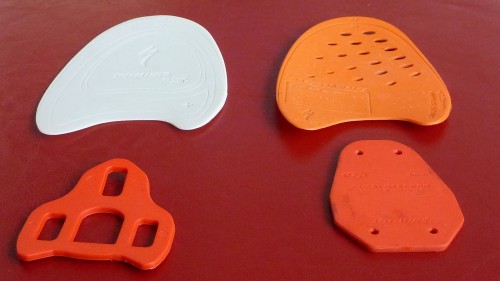
I’ve mentioned the history of these at the outset above. A pelvic shift in all cases.
SOME SUNGLASSES
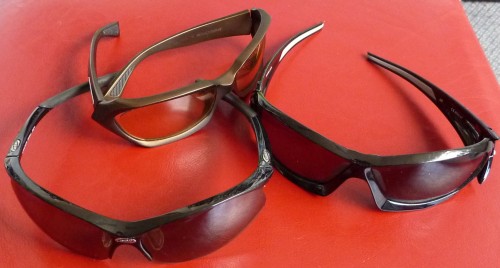
Many sunglass frames have a negative effect. I hasten to say not all, but of the ones that I’ve seen, a majority of black or dark coloured plastic framed sunglasses are problematic. The only brand that I have never found a problem with anyone is Salice. There is less of a problem with coloured sunglass frames. However, some coloured frames are a problem.
POWER BALANCE BRACELETS
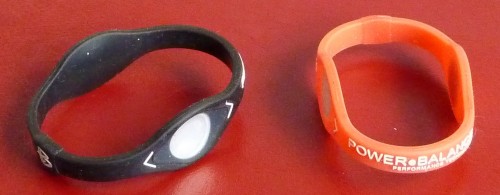
These are a con. They are sold as some sort of performance enhancement device. I can’t see how performance can be enhanced if anyone wearing one is walking or running around with a lateral pelvic tilt.
‘NEAT FEET’ GENERIC ARCH SUPPORT (AS WELL AS SOME OTHER BRANDS /MODELS)
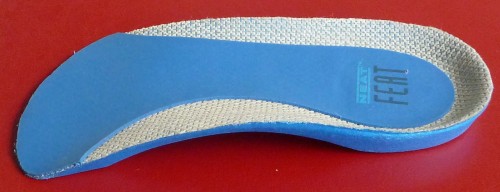
This particular generic arch support as well as some others is problematic. Most of the ones to avoid have a two tone colour scheme. If in doubt, test a number of people with an item that you are concerned about.
FOSS INNER TUBES AND RIM TAPES
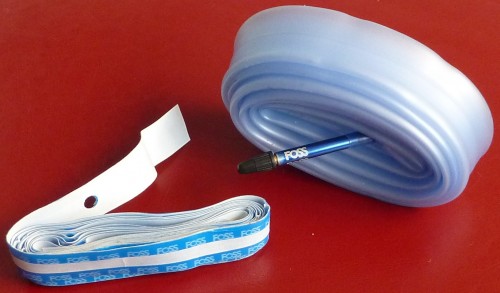
A bicycle wheel is within the exposure distance to the rider on the bike that will affect many people.
ANTI GLARE COATINGS ON SOME PRESCRIPTION GLASSES
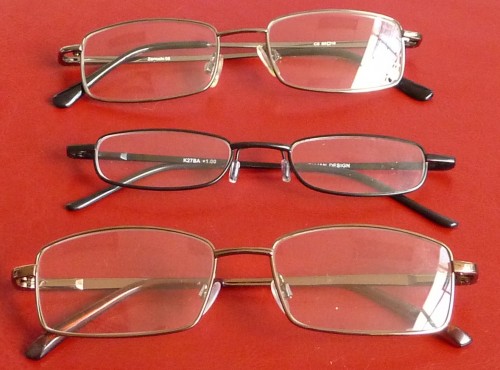
These and others like them are an exception. There will be no change in pelvic angle if the item is placed near the subject or held by the subject. There will be a pelvic shift when the subject wears the glasses and looks through them with eyes open. A number of people I’ve tested had 2 pairs of glasses with the same prescription, one for indoors without anti glare coating and one for outdoors with anti glare coating. In those cases the problematic ones were the ones with the anti glare coating. I have discussed this with a number of Behavioural Optometrists. Most were unaware of the issue but 2 that I have spoken with had already come to the same conclusion before ever they heard from me.
SOME SUNGLASS LENS COATINGS
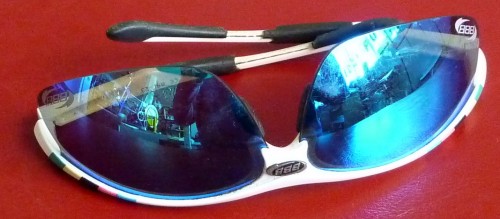
I’ve seen this a number of times with the brand above as well as several others. No problem holding or being near the glasses, but a pelvic shift when they are looked through.If the lenses are removed and held, no problem. But if the lenses are removed and looked through, the pelvis shifts. So again, like anti glare coated prescription lenses, it is not the material itself, but some form of coating on the lens that is the problem. With this type of item, there are differing individual responses. I had two athletes in from a national squad. Their kit is blue and white so they had white framed sunglasses with blue mirror lenses to match that were not team issue. They had provided their own and each had a different brand. Athlete 1 had glasses that were problematic for him but fine for his team mate. Athlete 2 had glasses that were fine for both of them . After seeing what happened to their pelvises while facing a large mirror, they swapped glasses.
It is important when testing sunglasses, that when there is no apparent pelvic shift when the subject holds the glasses, that the subject is retested with the glasses on and looking through them.
So how did this situation arise?
The simple answer is that the people responsible for product development of the items above weren’t aware of the negative implications for the human nervous system of the choices they made regarding the material make up of these products. I don’t think anyone was. I fell over this because I am a keen observer and seem to notice a lot of small things that others don’t. By all means wear or use any of these items if you wish because you aren’t going to die. What will happen is that at some level, great or small, you will function more asymmetrically which in turn lowers the threshold past which you will develop overuse injuries because of a Material Challenge induced decrease in pelvic symmetry.
Several brief case studies.
The one I mentioned above . I had a gent who had a history of minor but constant knee niggles on one side. I was able to trace that to the LiveStrong bracelet he was using to keep his spare tube in place inside his under seat tool bag. Once that was removed, his pelvis functioned more symmetrically and the knee pain disappeared.
Another was a women with right side low back pain on a bike. She was more functional than average. I felt she needed a small shim under one cleat. She already had a Specialized one. I removed it and replaced it with the same height of the type we manufacture. End of problem.
I don’t want to overstate this. Injuries that occur from riding a bike, crashes aside, are always overuse injuries. In simple terms there is a problem with the interaction of an asymmetric rider and a positionally symmetrical bicycle creating strain and misalignment somewhere that sooner or later causes an injury. No one functions perfectly symmetrically and so there is an individual degree of lack of symmetry and training load after which injury occurs. If you are going to use a product that will increase your functional asymmetry, you are one step closer to developing an overuse injury by reducing that threshold. So why would you take the risk?
As a post script, the unanswered question is why?
The spectroscopic analysis I referred to above showed that the Specialized wedges and shims are composed of plastics made with a heavy metals component. Testing of some of the other items above confirms the same thing. Some plastics have a heavy metal component and human nervous systems are very sensitive to heavy metals. My assumption, and I’m happy to be corrected if anyone reading this can add anything , is that any of these items placed with in a human magnetic field triggers a compensatory response. And as I’ve said ad infinitum on this site, all compensatory responses work by increasing asymmetry.
If anyone reading this can shed any further light on this, please feel free in the Comments section below.
Note: Often, more specific answers to your questions can be found in the Comments below or in the eBooks section and FAQ page.
To learn more about bike fit products offered by Steve, click here.
Do you have a bike fit success story? Please go here to share.
Thank you for reading, return to the Blog page here or please comment below.Comments (80)
Comments are closed.







how about Helmets? or things we carry in saddle bag – tyre levers? glue to stick tube patches? Or water bottles (black plastic caps?)? Or cycling computers and the mounts used to hold them (such as Garmin cradle mount on stem)? Bicycle Lights – front and rear? How many clients will carry everything on them when they come for a cycle-fit? I sure did not back in 2008….
G’day Yuri,
I never say never, but to date I haven’t found a problem with
any of the items you mention. Don’t get worried about my mention of black plastic. I said that most black plastic framed sunglasses that I have come across to date, not all. Funnily enough, often cheap no name brands are fine while many expensive brands are not.
Are you familiar with “negative ion” bracelets, clothing, etc., that “reset” a deleterious change in human magnetic fields from the type of objects you discuss in this article? I was recently muscle tested with/without such a bracelet, and noticed significant changes. I was skeptical, but your article is another reason I’m reconsidering my skepticism. Now I’m wondering if use of a negative ion device would reverse the effects of these objects – for example, using a negative ion bracelet while using a Specialized shim.
G’day Ben,
No, I’m not aware of negative ion bracelets. I am aware of
negative ion generators and trialled one in the shop a few years back. It made the dust settle and maybe I felt better for it and maybe I didn’t. I wasn’t sure so I didn’t shell out the bucks.
If you can tell me where to find a negative ion bracelet, I’ll check them out and see if they negate a Material Challenge. Better still, if you are confident you can locate iliac crests on a subject, try it yourself. Get hold of one of the items that I’ve mentioned as being a problem; confirm to your own satisfaction that there is a pelvic shift with that item close to your subject and then retry with the negative ion bracelet. I don’t know what you will find and would be interested to hear what happens.
Ben, you just need more carbs mate. 😉
I’m not sure if you’re pulling my leg or not. I need to read it a few more times to make sure I understand what you’re saying from your point of view, rather than my point of view.
G’day Rhys,
I don’t know whether you can competently locate iliac crests,
but if you can, work through the list I’ve provided and then decide whether it is a leg pull or not.
What heavy metals did you find?
Were iodine, cesium, strontium, plutonium among the heavy metals you found?
Were these atoms or any others of ionized isotypes?
If yes, I’ll have more to say.
If no, then my hunch is irrelevant.
Thanks for taking the time to write your articles.
Always fascinating and helpful in both cycling and structural/functional health off the bike.
G’day Constantine,
The metals tested for were Lead, Barium, Cadmium,
Arsenic, Selenium, Zinc, Copper, Chromium, Manganese and Nickel. The tested products were Specialized and Bike Fit. Both had measurable levels of all of these but as I know the Bike Fit products don’t prompt a pelvic shift, my assumption is that the issue is the metal that the Specialized items had a noticeably higher concentration. That was Zinc in approximately 3 times the concentration.
“Samples were microwave digested followed by ICPMS analysis” to quote the report. That will probably mean more to you than to me.
Steve, I’ve been suffering from various knee issues for ages and have had two professional bike fits, but my feet just never felt right tilted or eneven god knows – anyway, inspired by your writings I’ve aranged a fitting with Scherrit and ma hoping he can get me right on the bike! I’m frustrated and desperate!
Everything you’ve written makes total sense – but as a scientist I’m fascinated by this – I have both types of wedges and the guys in the lab next door have microwave digestion and ICP-MS so next week I’m going to see if they can tag on these materials to the end of one of their runs and see what comes up.
My first guess is that these metals are there as either “bits” from the stainless steel manufacturing vessels/pipes and catlyst residues. but, these are usually down at the parts per million level. Amazing if they have that effect.
Be interesting to see what polymers they’re both made of too.
If they’ll run them I’ll let you know what the results are – still, no written report though.
If this turns out to be true, you must be up for some form of honary Phd :o)
G’day Dave,
I would be surprised if Scherrit can’t make headway with your
knee problems.
Re your comments; I don’t KNOW that heavy metals are the problem and as someone who knows more about this than I do, maybe you’re right. I came to the view about heavy metals because I couldn’t find a reference to anything else that would have such an profound effect.
Then serendipitously, I had a fit client who was a Professor of Analytical Chemistry who was fascinated by the effect ‘Ive described and was able to demonstrate to him on a number of people. He arranged the analysis and if you’re interested, I’ll forward you a copy. Basically, the Bike Fit wedges have much higher Barium and Copper levels than the Specialized, but that is not a problem as the Bike Fit wedges don’t impact on pelvic alignment. The Specialized wedges have much higher levels of Zinc, so my assumption is that is the problem. Happy to be corrected if it is some other factor.
I’ve further assumed that the problem with the other items I’ve listed, lens coatings aside, is because of similar make up. Again, that is an assumption. With the lens coatings, that is different again because materially there is no problem or pelvic shift. The pelvic shift only happens when the subject looks through the lens. I know that 20% of the information from the eyes goes straight to the sympathetic nervous system
which would explain the effect on posture. Other than that, I can’t shed any
light on the lens issue.
I’ve put this stuff out there for 2 reasons. Firstly, to make cyclists aware
of the issue and secondly, in the hope that someone would read it who could
shed more light on the subject and take it further. Here’s hoping you’re in
the second category. I look forward to hearing what you find.
Fascinatings stuff, zinc certainly seems to have an effect in the diet.
http://www.healthandage.com/copper-deficiency-may-cause-poor-balance-23943
G’day Dave,
thanks for that though I doubt it is in the same general area
as what I’m talking about. Just a thought; you mentioned you have both Specialized and Bike Fit inshoe wedges. Before you chew up Specialized in shoe wedges in testing, use the procedure I’ve outlined about checking for a pelvic shift when holding or very close to them. Then restest the subject with the Bikefit inshoe wedges. I’d be interested to hear what you find.
“Administering a simple copper salt rapidly restored his balance.”
Do you get the same effect if subject wears a copper bracelet?
Dunno. Duplicate what I’ve outlined to satisfy yourself that I’m not dreaming and then do your tests as to material makeup.
Hi Steve
As you are well aware I have been fitted by you and I must say I am fascinated by this post. I knew you had some issues with some products but didn’t really know why. Next Time I see you I think it is important to be tested with the items I usually wear and carry when riding. Like heart rate monitor and cycling glasses to name a couple of things that spring to mind.I know some people who use some of the products you mention and have forwarded this post to them to read.
G’day Tony,
I’ve yet to see a problem with a heart rate monitor of any
brand. Nor a helmet of any brand. I should have tested you with your glasses on and apologise for the oversight. It is standard practice for Margaret to ask people to bring their glasses, orthoses etc.
Hey Steve,
Fascinating post. I love posts that include a homework assignment! Anyway, is it best to test for material challenges on subjects that don’t know the purpose of the experiment? I guess what I’m asking is can a subject that knows what you’re looking for mask a material challenge by consciously preventing their pelvis from tilting? Thanks again.
G’day Mitch,
The answer is probably yes, that it is best to test without
alerting the subject as to the purpose. I try to but it is not always possible in that I get a lot of word of mouth business and many people come in having heard something or other from a friend or acquaintance in advance. It those cases, it doesn’t seem to matter as to the result.
G’day Steve,
Another great article! After reading your articles I started to observe my body position on the bike more often as I know what to look for and slowly make changes (cleat position, additional 2mm insole for shorter leg shoe). Wondering how to apply this knowledge (arch support etc.) for Skiing and Ski touring as the proprioceptive output of the feet probably plays its role in this sport as well.
The FOSS inner tubes have caught my attention as I use the Eclipse Tubes which look very similar, but the material might be different. Any experience with the Eclipse tubes? I shall try to follow your instructions to see if I own some challenging materials items. Good to know my Salice shades are fine:)
Dusan
G’day Dusan,
I know very little about the technical side of skiing and
so am not sure of the answer. I assume the same principles apply. I’ve been getting a few runners and golfers in lately and to date, the results are positive. I assume skiing would be similar but don’t know that first hand.
Most inner tubes are black rubber. I don’t know what the Foss tubes are made from but it isn’t black rubber! I haven’t heard of the Eclipse brand and so have no experience with them.
If in any doubt about an item, follow the steps listed in the post. If you have enough anatomical knowledge to find the iliac crests on another person, you will soon find whether there is an effect or not.
Hi Steve,
Gees, if it wasn’t you writing this article I would have dismissed the article as soon as I read the first suggestion that plastic bands placed 2m away from you could tax your nervous system! Anyway, many thanks for another thought provoking and revelatory article!
Have you found dental fillings (the silver coloured amalgam ones) to pose a material change? I imagine there are quite a few people with these, and they are obviously something that is not easy to distance yourself from. Also, given their proximity to your brain, it seems to me that the potential for them to cause a significant challenge is quite high.
I seem to remember a tale of a friend of a friend who had several of these types of fillings removed at one point, supposedly because they could cause some sort of nervous issues and, amongst others, I was very sceptical at the time. Now, with your demonstrable findings, I’m thinking they may have been ahead of their time.
Many thanks in advance for your answer.
-Neil
G’day Neil,
I don’t blame you for your scepticism. You’ve been here some
years back so you know that I’m reasonably sane. That’s why I listed a protocol for others to duplicate.
Re amalgam fillings. This is one of the things that occurred to me, along with mobile phones and a whole lot of other stuff. To date, I have never found a problem with amalgam fillings in anyone, in the sense of a pelvic shift or an inability to get response with my testing procedure. Mobile phones are another thing that occurred to me as potentially being an issue once I stumbled over this. I haven’t found any evidence to date that they are, at least not in the sense I’m talking about.
I’ve got a head full of amalgam fillings and know an exceptional dentist with some neuro training. He removes a lot of amalgam fillings because he says they negatively impact on some people, though I forget his line of reasoning as it was some time ago. I asked him to look at mine, he ran a lot of tests and told me I was asymptomatic and not to bother doing anything about them. I do remember one gent who once told me that removing amalgam fillings improved his general health and well being. Sorry, but that is about all I know about the subject.
If it’s any help, Amalgam fillings post-placement are composed primarily of silver, with tin the other significant metal. There are usually traces of copper, and Zinc, but in single digit percentages.
Sensitivities or negative health effects are shown very rarely, and typically only in people with a known severe allergy to one of these metals. As you mentioned above, there have been many anecdotal accounts of positive effects from removal, but there has never been any published literature to support their replacement for most people.
Not specific to bike fit, but maybe a bit of background knowledge will help along the way somewhere.
Steve, a personal thank you for all the information you’ve provided on this site. it’s been a massive help.
Dr Scott Lundy, DDS
G’day Scott,
thanks very much for that. You’ve increased my limited
knowledge on the subject. I always thought that there was a high percentage of mercury in amalgam and that the mercury was the reason for some people’s concern.
Steve and all,
Just as an FYI for all of you, I am not sure where Dr. Lundy practices dentistry (from a quick Google, it looks like perhaps Canada), but over most of the world (including Canada and the USA), mercury comprises the majority of amalgam filling material.
Perhaps I misunderstood his reply, but he appears to state that silver is the primary component, and he doesn’t even mention mercury, whereas it is pretty well established that mercury is the primary component (at approximately 50%) and silver is only in the 25-35% range. He does have the qualifier “post placement” in his comment, but for that to be meaningful to the discussion, one would need to accept that the mercury comes out of the mix during the placement process, which simply can’t be the case for a host of obvious reasons (nor have I seen any reference to any such reduction in mercury % during placement).
There is a lot of controversy on the topic which I won’t get into but you can search Wikipedia for “Amalgam (dentistry)” and “Dental amalgam controversy” for a good starting point. It is important to note that it is an established fact that the mercury from fillings does leach out slowly. This happens both through vaporization and also chemical and mechanical breakdown of the filling material, and the mercury can then bio-accumulate in the body. It is also an established fact that mercury has undesirable effects on the function of the human body (in particular the brain and nervous system). The only question (and it is a big question) is not “Are you being exposed?”, but instead, “How significant are the effects of the exposure?”.
Now, relevant to the phenomenon that Steve has observed, one would have to assume that the amount of mercury contained in several amalgam fillings would dwarf the amount of mercury in most of these plastic products and, as Neil mentioned above, is in extremely close proximity to the CNS. If simple close proximity to mercury, in any form, caused this degradation of proprioceptive feedback, one would assume that fillings would also cause it, and to a much greater degree than the plastic products.
Assuming Steve is on-target with this, then I would have to guess one of two things:
1. One of the other contaminants (besides mercury) in the plastic is to blame. Since Steve has not observed this effect when one is in proximity to aluminum bike components, then you could also rule out Zinc, since it is used in 6061 aluminum alloys, and you could rule out other materials through a similar process of deduction.
2. It is not simply the presence of the substance that is the problem, but instead it is the form (which would allow mercury or zinc to come back in as candidates). This would mean that some property of mercury when mixed into an amalgam, or zinc when alloyed in aluminum, changes in a way that keeps it from interfering with proprioceptive feedback.
I would almost start to wonder about electrical fields and static charges, as there are those who think that EMFs and a lack of grounding cause CNS problems for the human body (Google “grounding health” for some info). However, from Steve’s descriptions, it sounds like the fitting clients in question remain pretty insulated from the ground regardless of the materials in proximity, and he has not observed this effect from any electronic devices, which would be much larger sources of EMF radiation.
Steve, thank you for all of your excellent fitting advice, and also for being willing to call it like you see it. I look forward to much more information on this topic (either supporting or detracting) as it becomes available.
Best,
Kai
G’day Kai,
Thank you for taking the time to comment in detail. My (very limited) understanding of the make up of dental amalgam is similar to yours, but my thought when Dr Lundy’s comment came is was “Maybe things are done differently elsewhere”. I can say definitely that dental amalgam fillings are not the reason for what I’ve posted about because many older clients have head full of them and I’ve found they respond the same way as those who don’t.
Re Zinc, yeah, was aware of high zinc aluminium alloys as well as high copper 2000 series alloys like brake calipers, many crank sets and so on. Again, no effect. I don’t KNOW zinc is the problem but after an analyis came back showing the major differences between Bike Fit products and the problematic Specialized products being higher Barium levels (Bike Fit) and higher Zinc levels (Specialized), I felt it couldn’t be Barium because there is no postural shift when close to Bike Fit in shoe wedges or cleat wedges.
My major reason for posting about this was in the hope that others would duplicate procedure I outlined in the post and see that I’m not dreaming. If enough people became interested then I was hoping that somewhere along the line someone would be able to shed some light on the subject.
My apologies, I hadn’t meant to mislead anyone. To clarify, Mercury is indeed a major component of my amalgam as anyone else’s. It’s role is to give plasticity to the material during placement. The operator’s condensation (ever wonder why the dentist is pushing so much?) forces the majority of the mercury out of mixture, however some will be undoubtedly left behind. Quantity can vary significantly depending on the manufacturer of the manufacturer and the operator.
I’ve heard multiple cases of reactions in people with an undiagnosed zinc allergy, never a report of mercury toxicity relating to fillings. I’d hoped that might provide a bit of relevance to the topic at hand.
Hey Steve, you helped me when I asked you some questions on cyclingnews a while back. You are getting a hard time on weight weenies about this article. Have a look at this http://weightweenies.starbike.com/forum/viewtopic.php?f=14&t=92094
Why don’t you defend yourself as I know you helped me a lot?
thanx Wil
G’day Wil,
I remember you. Glad that you got a result. Re the link; I had a
look and thank you for being concerned on my behalf. That thread illustrates why I keep away from forums.
I’ve put some info out there along with a protocol for others to follow to duplicate what I’m talking about. Apparently no one in that thread is interested in even trying to duplicate the procedure. Maybe it’s too hard for them to fit into their busy lives and less fun than sniping. I also note that one commenter seems to be someone that I’ve fitted in the past who attests to the validity of what he saw here. The telling thing about the thread is that is not a single sniper even bothered addressing his comments.
Good luck to them all. I’m not concerned.
Hi Steve,
Sorry to pester you, but have you ever encountered anyone for which an object presented a material challenge at one time, but the same object did not present a challenge for them at another time? Just wondering if a person’s response to an object is invariant, or dependent on other variables. Thanks again for sharing your experiences.
G’day Mitch,
You’re not pestering me. No I haven’t. At least not to date.
just wondering if the metallic components of the bike will affecting the pelvic shift ?
If not, why just rubber and plastic bits only ?
G’day Andy,
I’ve yet to find anything on a bike that is a problem. As to your question of why; I don’t know. The major reason I’m putting this info out there is in the hope that someone reading the post will be able to shed more light on what I’ve written about and take it further.
I wonder where the Specialized wedges are made? There has been cases of unexpected heavy metals, often lead, showing up in all sorts of products manufactured in one particular country.
G’day Wayne,
I don’t know where they are made. From the analysis report I have, I doubt that lead is the problem.
Hi Steve,
very interesting post. I just saw it and was eager to try so just tried it on my wife and it does seem to increase the iliac crest height on the one side when the livestrong band was held in the hand as opposed to being placed more than 2m away. But I have to say my wife does have pelvic issues so its prob not the best subject to try it to. Our clinic happen to be doing inservice on pelvic girdle amongst the staff this wednesday so will try it out then and see if we get some interesting results. Will keep you updated as we will have a few more physio eyes to check it out on.
Cheers
Eric
G’day Eric,
Thank you for bothering to follow through on the procedure. Whether your wife has pelvic issues or not doesn’t matter as there will still be a shift. I’ve tried this on something over 1500 people with and without all sorts of issue over the last 3 years without a single one not responding. And yes, very interested to what your team of physios find on Wednesday. Thank you for your interest.
Hi Steve,
We did the test today at our inservice and just to be objective i did not tell the other physios what we are testing for apart from looking at the height of the iliac crests and we used the same subject whilst 3 other physios looked at the relative height and only revealing what they thought at the end. We all observed a difference in iliac crest height when the livestrong band was held in the hands whilst it was levelled initially without the band and more than 2m away. It was only at the end that I showed them the contents of this blog article. Just for a bit of credential we had PHD and Masters qualified physio with a lot of clinical years experience that participated this test. Obviously there are still skepticism that arised with the physio but certainly the relative height of the iliac crest was different when being tested with and without the band.
Cheers
Eric
G’day Eric,
I was confident that anyone who could repeatedly find iliac crest heights on a subject would find as I’ve written about. But a large thank you anyway for taking the time, making the effort and enlisting your colleagues. Did any of the care to hazard a guess as to mechanism?
Steve
Not sure if you have already mentioned this but what about after market mobile phone covers?
I know mine is a rubbery plastic similar to the wrist bands.
I know you have said phones seem OK, but what about the protective after market covers?
G’day Steve,
I don’t know. I can’t remember ever testing a phone with plastic cover. If you have enough anatomic knowledge to repeatedly find the iliac crests, follow the procedure outlined and tell me what you find. Alternately, next time you visit your chiro or physio of choice, ask them to check.
Great stuff in your blog entry!
I would like to see the actual data and test procedures that resulted in the conclusions you reached, particularly about wearing “charity bands” and using some anti-reflection coatings on glasses. For such conclusions to be reached, scientific method has to be strictly adhered to. Note that scientific method is not a 4 step, one shot process. It’s iterative. Part of that process is allowing others to see the data used, to replicate your “experiments”, and to see how their results compare to your “results.” Otherwise, claims about results are no more than unverified statements.
How many “tests” did you run to make the conclusions you’ve made? For example, how many test subjects were used to determine that pelvic tilt is a function of the polarization state of light incident on a rider’s eyes? Such extraordinary claims require extraordinary proof. You’ve provided none of that proof, but you do expect people to believe what you’re saying. Sorry, that doesn’t stand up to critical analysis.
Without specific proof–raw data, sample set size, number of tests, experimental setup (including what parameters were held constant and what parameters were measured)–there’s nothing to indicate that any your claims hold any water. Sorry, that’s how science is done, and that’s how critical thought and analysis work.
G’day PlsSquared,
I agree with most of what you’ve said but ask you to
read the post again. The answers to your first two questions are there. To summarise; I have a method that I don’t wish to disclose because it is the subject of a patent application in several countries. I have outlined a procedure within the post that anyone with reasonable anatomical knowledge can duplicate and make their own judgement.
And no, I don’t expect people to believe what I’m saying, I suggested as much early in the post. I’ve asked that anyone interested enough attempt to duplicate what I’ve outlined, in the hope that someone out there will have enough knowledge to advance what I’ve described further in terms of working out the ‘why’. I’ve listed what I know.
If you look at one of the comments prior to yours from Eric, he appears to have been the only respondent to date who has bothered to attempt to duplicate the procedure I’ve outlined and found something similar as did other physios he mentions. I am happy for you to disbelieve or not as you choose but would be happier it you disbelieved after attempting the procedure I’ve outlined and finding no change. I’m confident you will find a change.
As to research / method / sample size etc; I take your point but have no interest in research beyond a point. I’m a bike fitter not a scientist; this
is a blog, not a scientific journal. I put the info out there in the hope
that people would give what I’m saying a try and find the same effect or
otherwise. Why don’t you try?
Sample size?
Somewhere between 1500 and 2000 over the last 3 years without a single non
responder to the items I’ve listed but some variability as to the glasses as
listed. I gave up counting after 1000 or so. I’ve shown this to I don’t know
how many health professionals; not hundreds but many tens, without any one
finding other than what I have described. Again you can choose to believe
what I’m saying or not. Try the method outlined and make a personal and
informed judgment.
So, to be clear: you’re saying that your observations of anti-reflection coatings and their impact on rider/bike karma were made over 1500-2000 samples? Really? You noted that effect and whether or not it was seen in each of those cases?
In the world of science, it’s not up to everyone else to prove one person’s extraordinary claims wrong. Certainly any low sample “replication” of what you’ve “done” is not proof of anything. Read up on “sample size” and “statistical significance”. Moreover, your instructions to the readers on how they can test your “theories” is anything but rigorous and certainly doesn’t constrain the “tests” enough to determine whether a yellow charity band takes the glint off of someone’s riding che.
The claimant has to prove their claims correct. You haven’t done as much. Moreover, fact is not open to belief, except to Deepak Chopra, politicians, and other people selling’ stuff.
I think the word we’re looking for is “hokum”. That’s it. Pure and simple.
G’day PlsSquared,
To be VERY clear. What I am saying is that since I noted what I have written about, which was 3 and a bit years ago, it has been standard practice here to ask all fit clients to bring there shoes, glasses that they use on the bike (whether sunglasses or prescription glasses), any inshoe foot correction, etc, etc. In that time I’ve seen that number of people. Not all have have had glasses that had the effect I’ve described; some did. Not all had the other items I’ve mentioned that triggered the effect; some did. Very soon I collected a bag of those items discarded by clients which I have tried on every fitting client. I see 5 – 700 people a year and yes, not a single non responder to some of those items. Some variance in response to other items. That is Specialized in shoe wedges and cleat shims, charity bracelets and Power Balance bracelets and the other items I have mentioned. Exactly as I have said in the post.
I’ve got no problem with your scepticism. I do have a problem with those who display certainty about their scepticism without attempting to find out for first hand. I’ve no time or interest in being a researcher. I’m happy to put the info out there in the hope that someone will either shoot it down via first hand experience or confirm it via first hand experience. You’re not prepared to do either. True scientific method, at least my understanding of it, is to reject nothing outright and investigate anything of interest. Armchair criticism will only take one so far.
To be even more clear, I don’t have the slightest problem with your disagreement providing it is based on first hand experience with what this post is about. The procedure is there, put it into practice as several other commenter’s have, and see what you find.
Hey Steve,
As evidenced by my previous question, I was concerned that prior knowledge of the phenomenon would make assessment difficult. I wanted to determine if the AR coating on my glasses was a problem for me. I have AR coated glasses for daily use, but I usually (although not always) ride and exercise with a pair of sports glasses with no coating. Anyway, I went to a local physio and asked to be put through a functional movement and balance assessment a few times: once with no glasses, once with the uncoated glasses, and once with the AR coated glasses. The difference was obvious. After I told her what I was trying to figure out, she made me do the assessment over a few times. No matter how many times I went through the assessment routine, the results were the same. For me, the deep squats were the exercise where the effect was most obvious. It may not be the case for others, but doing a deep squat well requires symmetric movement and good hip mobility. Someone may be unaware that their pelvis has tilted slightly, but there is no mistaking how well you can perform a deep squat. Anyway, really fabulous work figuring this out. It turns out I’ll be saving a little money next time I have a change of prescription, as I won’t let the optician talk me into an expensive AR coating. Thanks again.
G’day Mitch,
Thank you for being interested enough to have a shot at it.
It is nice to know that the first two who have attempted to duplicate what the post is about have got the same result. Do you or your physio have anything further to add in terms of mechanism?
I know something like 20% visual information plays a part in balance and coordination and my supposition is that the anti glare coatings, where they have an effect, have some disruptive effect on that. That still doesn’t explain the mechanism involved with the items that trigger a pelvic shift just by being held or placed close by. If you come across anything, please let me know.
If a rider stripped bare of all these influences has a natural pelvic tilt, would “fitting them” with say a rubber bracelet possibly create a tilt that may neutralize their posture?
G’day GM,
I’ve seen it happen. Basically the pelvis will shift. It is
more common for the left iliac crest to rise but there is substantial minority for whom it is the right side that lifts. If someone has a pelvic tilt to start with there will be a shift. If the shift is in the opposite direction, then yes, the subject may end up level or closer to level.
Steve,
I have nothing to add regarding mechanism, nor did my physio. To say she was surprised is an understatement, so she was still trying to wrap her head around what happened. But, she said she’d follow up with colleagues and let me know if anyone comes up with a plausible explanation. We didn’t test any of the other products you mention, since neither she nor I had any of them, but I pointed her to your blog. I suppose it’s possible that the mechanisms for the AR coating and other material challenges are different, even though the results are the same. If I come up with any ideas worth pursuing, you ‘ll be the first to know. And if my physio comes up with something but doesn’t wish to post it herself, I’ll post her contributions. Thanks again.
G’day Mitch,
thanks. There must be a difference in mechanism between the
anti glare coatings and the plastic bits and pieces I mentioned. In my experience with this to date, it is uncommon for a metal framed pair of glasses to cause any shift just by being held or nearby. The shift happens only when the glasses are worn and looked through, assuming the glasses are problematic of course.
I’ve got some more to add about the effect of visual processing on posture and will eventually post on once the fuss from this post has died down a bit.
Hey Steve,
I received the sample shims you sent a few weeks ago — thanks. I had been delaying the change from the Specialized shims because it’s such a hassle to get 9mm of shims and the cleat to line up and get the float centred (unfortunately I’m not using Speedplay anymore — dirt troubles). But as soon as I saw this article they were off my shoes the next day. I’ll report back any findings, but you’ve probably seen it all before…
I wish you could publish a list of all the items you’ve found that cause problems. I’d like to get some new glasses but I’m sure the shop would find it a bit odd if I went through each pair one-by-one and did the test to find the models that did not cause a change…
There are so many things that we carry — tire levers (seems to be the same sort of plastic as the Specialized shims), pumps, iPods, cell phones,… I’m going to have to acquaint my wife with your procedure…
Your posts and articles have been awesome. Thanks for sharing your knowledge.
G’day David,
Here’s a list below.
Charity Bracelets: To date, a negative effect on everyone tested.
Power Balance Bracelets: To date, a negative effect on everyone tested
Specialized In Shoe Wedges and Cleat Shims: To date, a negative effect on everyone tested. I have some Specialized cleat wedges, colour black. To date no problem with anyone with them.
Neat Feet blue and grey generic arch supports: To date, a negative effect on everyone tested.
Vasyli two tone blue generic arch supports: To date, a negative effect on everyone tested. Vasyli make numerous other arch supports that I have not seen a problem with.
Black plastic framed sunglasses: To date, a majority are a problem but there is a substantial minority that are not.
Coloured plastic sunglass frames: Some are an issue for some people but there is wide individual variance. Meaning a pair that has a negative effect on one person may not on the next.
Sunglass lenses: I regularly see people for whom there is no problem with the material in the sense that having it nearby does not trigger a pelvic shift but there is pelvic shift when the glasses are looked through. Again, wide individual variance.
Foss brand (polyurethane I think) inner tubes and rim tapes: To date, a negative effect on everyone tested.
Prescription glasses with anti glare coatings: To date, almost all have a negative effect on those tested.
Tube patch cement: I only came across this last week as most people carry CO2 cartridges. It is not the glue that is the problem but the metal tube it comes in. I’ve only tested this on a dozen or so people to date with a negative effect on each.
I haven’t found any problem with mobile phones to date. I was asked a week or so ago about the rubber covers on Iphones and Ipods but have yet to see any. When I do, I will post accordingly if there is a problem. I haven’t found a problem with tyre levers or any other bike related plastic bits like helmets, computer mounts or the like.
Steve
Great info as always. Can you list any particular sunglasses I can use with out having to worry about this issue.
Bill
Hi Bill – Steve lists Salice as a brand he hasn’t found to cause issues to date.
G’day Bill,
the only brand of sungglasses that I have never seen anyone
have a problem with are Salice. There may be other brands that I am not aware of. Even the Salice black frames are fine.
Hi Steve and readers.
I have had 2 bike fit sessions with Steve over the last couple of years and have respect for him as a bike fitter and an individual. I had sent the link to this post to some cycling friends and it created a decent amount of discussion,it seemed there was a fair bit of confusion about what Steve was saying. I reread the post and as I had read the previous posts, felt like I had a decent understanding of what was being put forward. I wondered how well the others had read the post or was my understanding helped due to having the bike fit sessions with Steve and experiencing the testing procedures first hand.
The chiropractor I see on a monthly basis for routine maintenance is a keen cyclist and was very happy to help us conduct our own testing with some of the products mentioned in Steve’s post. Unfortunately 2 guys had to cancel at the last minute and they had the specialized products so we were unable to include these items in our tests. We ended up having 6 guys,a Livestrong bracelet and various cycling eyewear.
I had printed out Steve’s suggested testing protocol and brought it with me to our gathering.Our Chiropractor is experienced in muscle testing based on Kinesiology and was happier using his own testing procedures. His testing showed the Livestrong bracelet induced a muscle weakness in all 6 people he tested whilst having the bracelet in contact with their body.
The eyewear tests were interesting with varying results with different people. We all tried each others glasses,some people had no negative reaction to any of the glasses and some had negative reaction to some but not others. One guy who had a negative reaction to his own eye wear later made the comment ” You know I always feel like taking my glasses off when I’m on a climb”,we wondered if this was his body telling him something.
So everyone of us felt the negative effect the Livestrong bracelet had on our muscle strength when tested using our Chiropractors procedure. Whilst different to Steve’s test, the results left us in no doubt none of us would be wearing one of these bracelets whilst riding our bikes.
Regards
Tony Reeckman
G’day Tony,
thank you for taking the time and trouble. Did your chiro have any explanation?
G’day Steve,
First of all, thank you for all the advise on the blog. I discovered it last month and I’ve been hooked.
My apologies if my question has been answered and I can seem to find it. I use Specialized shoes. I have been measured with the Bike Fit FFMD as having a flat foot across the forefoot. Given the material challenge presented by the Specialized valgus wedge, and the fact that the ITS wedges are for varus only (or so the say), what is the best solution for neutralizing the built in varus tilt?
G’day Patrick,
Thanks for the positive thoughts. If you are trying to
find a direct substitute for your Specialized in shoe varus wedges; use the Bike Fit ITS wedges one for one. If you find that inshoe wedging takes up a lot of room in the toe box, try using cleat wedges on a one for one basis. Cleat wedging will usually work as a direct substitute but there are occasions where it will not.
Then there is the entire question of whether you really need forefoot wedging (which will directly correct the forefoot and indirectly correct the rearfoot in cycling) or rear foot wedging. I find the latter is far more common but for the meantime, I suggest you don’t open that can of worms and just get hold of some BikeFit ITS in shoe wedges.
Hi Steve,
Thanks for all the great articles and advice on your site. I use Specialized Body Geometry shoes that have an built in 1.5 varus tilt. Have you tested whether Specialized shoes alone cause the negative effect seen with their wedges? Also I use Sidas conformable footbeds have you tested these in your protocol? I have been suffering from foot pain on the outside of my right foot for over a year, I have tried a whole variety of bike fit wedge combinations, currently riding with 4 on my right shoe (plus the 1.5 that is part of the shoe itself).
THanks
Simon
G’day Simon,
Specialized shoes have no negative effect. In addtion,
Specialized shoes don’t have any wedging built in to them. No, I have never seen a pair of Sidas insoles. Formthotic are the approximate equivalent in Oz.
Re your right foot issue; have you used level 2 arch support?
Hi Steve,
Thanks for the suggestion, I have tried a whole variety of arch supports from the fairly flimsy insoles that Specialized make to using my every day cutom made carbon fibre insoles that I wear to correct my flat feet. Nothing seems to make a difference. As for the shoes I will trust you as you are an expert, but Specialized do claim in their promo literature that their body geometry shoes have a varus wedge engineered into the outsole.
Since reading your site I think that I have commited the error of building modifications to the wedge set up one on top of another without returing to the baseline set up for a period. I think I’ll try this approach moving forward.
Cheers
Simon
G’day Simon,
My reason for saying that Specialized have no cant built
into their shoes is as follows. I often have fit clients coming in with 2 or more pairs of shoes to set up. If one of those pairs is Specialized, which it often is, and using a testing protocol based on CNS feedback to determine foot correction as I do, I have never found Specialized shoes to require a differing amount of foot correction to any other brand. If there was effective correction built in, then they would.
Steve,
As to the Specialized shoes not having any wedging built in to them, is it because they [attempt] to address forefoot varus as opposed to rearfoot varus? Are their claims marketing BS to sell shoes? Or something else?
G’day Patrick,
I don’t know is the answer. Not everyone needs rearfoot
correction, though it is more common. I have never pulled a Specialized shoe apart and looked for built in correction. All I can say is that I use a definitive method to determine foot correction and using that, Specialized shoes need the same amount of correction for a given rider as any other second brand of shoes that the rider possesses.
This is the biggest amount of BS I have ever read. A bracelet inside a tool bag can affect how someone sits on a bike, cmon.
G’day Unbeliever,
You’re view would be more welcome if it was an informed one. Duplicate the protocol as listed in the post and see what you find. I’m confident that what you will find is as I have written as have the several commenters who have gone to the trouble. Whatever you find, your view will then be an informed one. Until then, arm chair criticism is just hot air.
I find this facinating and not improbable. I’m wondering if you have ever tested the rubber-like cases for smart phones. The material is similar to the charity braclets shown. Thanks
G’day Hawk,
To date, I’ve haven’t found a problem with phone cases.
Someone else mentioned that a while back and I’ve probably seen 15 -20 clients since with phones in cases. So far no problem. I’m going to have to write an addendum to this post soon because a couple of other things have come to light.
Hi Steve
Have you experienced any issues with the Rudy Project Hypermask with Photochromic Laser Racing Red Lenses? http://www.erudy.com.au/shop/product.php?productid=18614&cat=541&page=1
I’m looking for some sunglasses without a top rim to use while time trailing. Have you seen any other rimless sunglasses that don’t cause issues?
Thanks
Dan
G’day Dan,
Unfortunately I have zero experience with the Rudy’s you
mention. The only glasses I’ve seen with no upper frame rail are several pairs of Catlike that look similar to the Rudy’s. In each case the rider had an issue with them. However this is 3 or 4 pairs max so don’t want to be definitive about such a small sample.
An attempt to reduce if not solve some of the negative effects of items described above was this:
http://www.patentstorm.us/patents/6914019/description.html
Interesting to see how different perspectives still lead to similar observations.
Thanks Gotz,
I’ll have a read.
For the purposes of filming and measurement could you draw cross hairs on the subject’s iliac crests and then film? Would this display the effect (obviously the iliac crest is under the skin but the visual texture might portray the movement?
G’day Chris,
We tried a number of things; including placing large marker
pen dots on the iliac crests. There was no problem seeing the movement in the flesh but the consensus (there were half a dozen of us) was that on screen it wasn’t nearly as obvious. I went ahead with the post anyway because anyone who goes to the trouble of trying the method I outlined will find the same thing.
If a cyclist being fitted cannot change the items that are causing the effect, do you fit them based upon the items that they normally carry?
I was appalled at the scientist’s attack on you. However his comments made me think. Have you observed a rider outdoors to determine if the pelvic shift occurs while riding? What I mean is that if these small items are having this type of effect; it would seem logical to me that the fluctuations one encounters in the Earth’s electromagnetic field would cause a constant shifting of the pelvis as one encounters these variances in the electromagnetic field while riding. This would indicate that dynamic testing would need to be done to validate the static testing before one could recommend making material changes. Of course it would be valid for cyclists who spent significant time on their trainers. Which brings another question, have you observed any changes causes by stationary trainers?
G’day Dekindy,
I’ve yet to see an item that causes a material
challenge that cannot be changed. I’ve never seen a material challenge from a bike frame, bike component, bike computer, seat, bidon, heart rate strap or similar. I have seen it from the bracket and rubber band on one brand of light, one brand of tube, one brand of rim tape, some bike fitting accessories, a few helmets and all of the stuff mentioned in the post . These are all things that can be changed.
There will be a follow up post in the foreseeable future as I’ve been putting some time into this and have found that with sunglasses, anti glare coated prescription glasses ,some helmets and a few other things (not all though!) that cause a material challenge, that the problem isn’t so much the material, but the polarity of the material. I think I have found a way to reverse the polarity of those items but I want to see whether it is a temporary or permanent effect before writing anything about it.
Re your comments about outdoors observation. If you re read the post you will see that this effect first came to my attention while developing a method of measuring how well the cerebellum recognised the proprioceptive output of the feet. It was only later that I found that a material challenge also caused a shift in the pelvis. I only use the ‘observation of pelvis’ method to show those people the visible effect of a material challenge who I don’t want to reveal patent pending IP regarding the testing procedure for proprioception to. So I’m not out there testing people on their bikes.
Re your comments about the Earth’s magnetic field, it is variable depending on proximity to the poles and extremely weak. You can buy magnets that exert far more force on a human being than the magnetic field of the Earth so while I don’t know the answer, I would be very surprised if the Earth’s magnetic field is implicated when a material challenge is present. I own magnets with a strength of several thousand gauss. The strength of the Earth’s magnetic field at any point on the planet is a fraction of 1 gauss.
Re your comments about stationary trainers. When testing for a material challenge with the IP that I mentioned above, the initial testing is done off the bike and then confirmed on the bike. I use 3 different trainers for fitting. A Sidea SB4 with inclinator, a Mikkelsen frame modified to take a Velotron and a Lemond Revolution for 29’ers and other bikes that won’t fit on the SB4. The SB4 and Mikkelsen / Velotron have very powerful electromagnets as part of their resistance system. To date, with testing done on thousands of subjects over a period of nearly 7 years since I stumbled over this stuff, the magnetic fields of the trainers have had zero impact on negating or increasing any material challenge present.
So to summarise; when testing for a material challenge, I don’t usually use the pelvic shift observation unless the client thinks I am trying to pull the wool over their eyes (which happens occasionally). With clients sceptical of my normal procedures, I stand them facing a large mirror while stripped to the waist and then show them what happens to their pelvis when I move any object that causes a material challenge close to them (presumably within their magnetic field). In some cases where it is the act of looking through some lens types rather than the material makeup that triggers the pelvic shift , I have them take the glasses on and off so they can see the difference in their pelvic alignment with and without. No matter how sceptical, I have yet to meet a client who isn’t convinced when they are used as the subject.